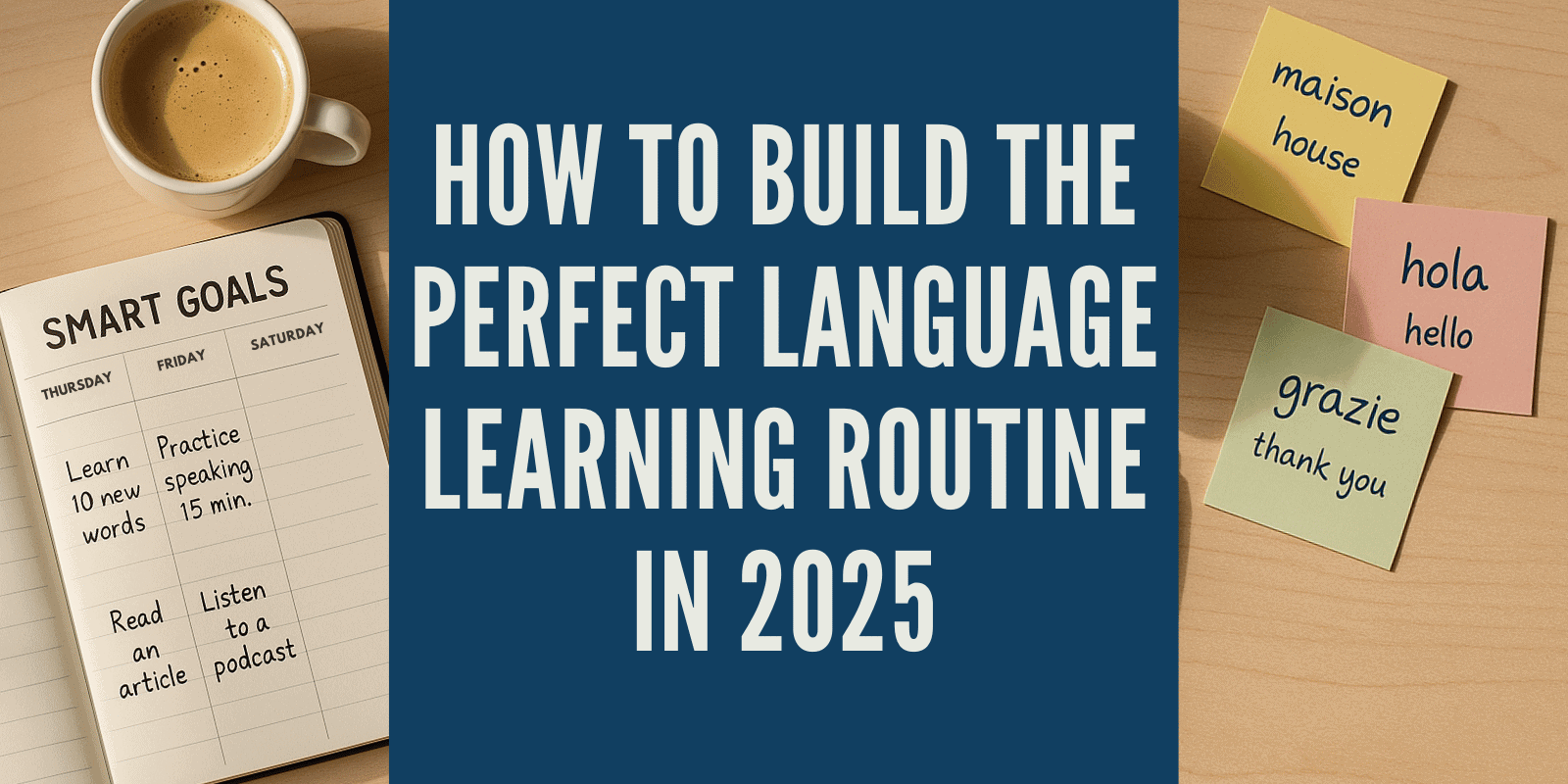How to Build the Perfect Language Learning Routine in 2025

What makes a successful language learning routine in 2025?
I often hear language learners say: “I’m too busy to study right now — I’ll start next month.” But the problem with this mindset is clear: if your routine depends on having free time, you’ll give up as soon as life gets busy again.
Others say: “I’m just not good at learning languages.”
But here’s the truth — it’s not a lack of talent, it’s a lack of structure. They haven’t set clear goals, tracked their progress, or built a plan that fits into their daily life.
The good news? Once you design a simple, consistent routine, the guesswork disappears. You’ll know exactly what to do each day, and progress becomes almost automatic.
Let’s walk step by step through how to build the perfect language learning routine for 2025.
Step 1: Set Clear Goals Using the SMART Method
The very first step in building a strong language learning routine is setting clear goals. Without them, it’s like driving without a map. Follow the SMART method.

- Specific
- Measurable
- Achievable
- Relevant
- Time-bound
So, instead of saying:
❌ “I want to improve my Spanish.”
👉 Say:
✅ “I want to reach a B2 level of Spanish and hold a 10-minute conversation with a native speaker.”
That’s much specific, measurable, and realistic.
Another popular approach is the 80/20 rule language learning, which focuses on the most effective study activities.
Identify Your Motivation
Start by asking yourself: Why am I learning this language?
- For work → maybe your goal is to sit a professional exam or to manage video calls.
- For travel → you need to focus on everyday survival phrases when visiting a new country.
- For fun → it could be because you want to watch a TV series without subtitles.
Your motivation will help you choose the right kind of goals.
Set Realistic Timeframes
Daily life gets busy, so deadlines matter. Balance ambition with practicality by setting short- and long-term targets:
| Timeframe | Example Goal |
|---|---|
| 3 months | Learn 500 new words and reach an A2-level of grammar |
| 6 months | Be able to talk for 5–10 minutes with a native speaker |
| 12 months | Pass a B2 exam or watch a Netflix series without subtitles |
If you break down goals like this, you will stay motivated and avoid burnout.
Step 2: Make Sure Your Routine Matches Your Learning Style
Everyone learns in a different way. The best language learning routine is the one that works for you.

Common Learning Styles
- Audio learners → Podcasts, audiobooks, or apps that focus on listening. Try listening during your commute, at the gym, or while walking the dog.
- Textbook learners → Structured grammar guides and online courses. If you prefer a more guided, step-by-step approach, a digital course like Mondly works well (see my full Mondly review for details).
- Visual learners → Netflix with subtitles, YouTube channels, or short-form videos. Even watching one episode a night builds consistency.
- Social learners → Language exchanges, online tutors (like italki), or community apps (HelloTalk, Tandem). Great for practising real conversations.
Diversify Your Study Plan
There is no single method for every goal. A balanced routine usually includes:
- Reading & listening ( known as passive practice)
- Speaking & writing (known as active practice)
If it’s not possible to go abroad, you can still connect with native speakers online. This will really help with your speaking and listening skills and also give you some cultural insight. This is something you won’t always get from a textbook.
Step 3: Build a Structured Daily Routine
The secret to language learning success isn’t intensity. It’s consistency. A well-structured plan will include regular practice, but make sure you don’t get fed up. It will make progress feel automatic.
Common Challenges to Avoid
A lot of people I speak with have unrealistic expectations. It’s not uncommon for students to think that if they just attend a 1-hour class twice per week, they will be bilingual within 6 months. Unfortunately, that’s not the case.
Language learning is a gradual process, which is why setting clear goals and milestones (Step 1) is important. Be motivated instead of frustrated.
Make Consistency Part of Your Lifestyle
Your routine should fit naturally into your day:
- Are you a morning person? Start with 15 minutes of review before work.
- Are you a night owl? Set aside time in the evening.
- Do you have a busy schedule? Even 10–15 minutes of focused daily practice is better than cramming just one day a week.
A balanced routine should include all skills: grammar, vocabulary, listening, and speaking. You can dedicate different days (e.g., “listening Mondays,” “grammar Wednesdays”) or mix them into every session.
One fun way to keep practice light is by using ESL warm-up questions as quick conversation starters.
Combine Active and Passive Learning
Strong routines incorporate both types of practice:
- Passive learning → reading, listening, watching content. (Example: listening to a podcast on your daily commute.)
- Active learning → speaking, writing, interacting. (Example: keeping a daily journal or regular conversation practice)
✅ Passive = input.
✅ Active = output.
Both of these are essential for achieving fluency.
Step 4: Use the 15 / 30 / 15 Method
One of the best ways to structure your study routine is the 15 / 30 / 15 method. It’s simple, flexible, and fits easily into a busy day.

How It Works
| Time of Day | Activity | Duration |
| Morning | Review previous material | 15 min |
| Afternoon | Learn new content | 30 min |
| Evening | Reinforce what you learned | 15 min |
This approach will ensure that you:
✅ Regularly revisit what you’ve already studied (spaced repetition).
✅ Dedicate focused time to covering new content.
✅ Reinforce what you’ve studied that day.
Why Is It Effective?
The power of the 15 / 30 / 15 method lies in spaced repetition. Instead of cramming in one long session, you return to the language several times a day, which strengthens memory and builds fluency more naturally.
Step 5: Embrace Mistakes + Celebrate Wins
A truly effective language learning routine isn’t just about study sessions — it’s also about mindset. The learners who make the fastest progress are the ones who treat mistakes as part of the process and celebrate every milestone along the way.

See Mistakes as Stepping Stones
Every slip — whether it’s mispronouncing a word, forgetting new vocabulary, or mixing up grammar — is a signal of what to work on next. Think of mistakes as part of your language studies, not as failures.
✅ Mispronounced a word in your target language? That’s a cue to practice your speaking.
✅ Struggled to remember vocabulary words during a conversation? Add them to your review list for tomorrow’s morning routine.
Recognise and Celebrate Achievements
It’s just as important to celebrate when things go right. Progress in a new language can feel slow, so setting milestones helps you see how far you’ve come.
Some examples of “small wins” worth celebrating:
- Finishing your first audio course without pausing for translations.
- Reading a few pages of a book or article in your target language without getting stuck.
- Learning 20–30 new words in a week and using them in sentences.
- Holding your first 5-minute conversation entirely in your target language.
Acknowledging these moments boosts confidence and reinforces positive learning habits.
Make Reflection Part of the Routine
Set aside time to look back at what you’ve achieved — weekly or monthly. You’ll see patterns: which study methods work best for you, what you retain from focused study, and which areas need more attention.
Remember: every step forward, no matter how small, is progress.
Step 6: Create the Right Study Environment
To make your language routine as comfortable and enjoyable as possible, you have to create a comfortable environment to study.
Find Your Ideal Study Space
Choose a place where you can focus without any interruptions:
- A quiet room in your house
- A corner in your local library
- A quiet café without any distractions

By dedicating a specific space to your language studies, you train your brain to switch into “learning mode” the moment you sit down.
Make It Comfortable and Motivating
- Add vocabulary words or sticky notes to your desk or wall for quick review.
- Keep a small notebook nearby for jotting down new vocabulary during your session.
- Use background music (classical, lo-fi, or ambient) if it helps you concentrate.
Switch It Up for Fresh Energy
Sticking to one space every day can get monotonous. Occasionally, change your environment to keep things interesting:
- Do some target language reading in a park.
- Take an audio course on a walk.
- Visit a local café and practice ordering in your target language.
These small changes create mini “immersion moments” that connect your learning to real-life situations.
My Favourite Tools for 2025
There’s no shortage of apps and platforms out there, but not all of them will fit into your routine. Over the years, both as a teacher and a language learner myself, I’ve tested dozens — these are the ones I keep coming back to in 2025.

Language Learning Apps
- Duolingo – Fun, gamified, and perfect for short bursts of study. It’s not a complete solution, but it’s fantastic for motivation and building a daily habit.
- Mondly – A great option if you like interactive lessons with speech recognition. I’ve written a full Mondly review if you want more information on how it can work for you.
- Babbel – Strong on grammar and practical conversation skills. If you’re curious how it stacks up against Duolingo, again, I’ve compared them in my Babbel vs Duolingo guide.
Online Language Tutors
- italki – This is still the best place to find affordable one-to-one tutors. You can choose from either structured lessons or relaxed conversation classes.
Podcasts and Audiobooks
- LanguagePod101 – A huge library of podcasts in multiple languages. This is good for listening to real-life dialogues.
- Audible – This is an underrated tool for learners. Listening to audiobooks (even just a few pages a day) can massively improve comprehension.
Language Exchange Communities
- Tandem and HelloTalk – These free platforms connect you with native speakers around the world for text, voice, or video chat. They’re perfect if you don’t have easy access to a local language exchange.
AI and Vocabulary Tools
- ChatGPT and other AI apps – You should definitely take advantage of these in 2025. You can role-play conversations, get instant corrections, and generate personalised language studies.
- LingQ and Memrise – Both excellent for new vocabulary and target language reading. LingQ works especially well if you want to learn by reading real-world articles and stories.
Why These Tools Work
The point isn’t to use all of them — that would be overwhelming. The trick is to choose one or two that match your routine. For example:
- Want to build a morning routine? Use Duolingo or Mondly for 10 minutes while you drink your coffee.
- Need more focused study? Schedule a weekly italki lesson and review your notes with LingQ.
- Looking for immersion? Put on an audio course or audiobook during your commute.
Final Thoughts
Building an effective language learning routine in 2025 isn’t about studying for hours on end. It’s about finding a structure that fits into your life, keeps you consistent, and gives you regular wins along the way.
Set clear goals, choose methods that match your style, and make study part of your daily rhythm. It doesn’t matter if that’s a morning routine with 10 minutes of Duolingo, a lunchtime session of reading, or watching an episode of a foreign language series.
What matters is that you show up regularly. Every bit of practice adds up, even just a few minutes a day.
Updated FAQs (2025)
1. What is the best language learning routine?
The best daily language learning routine includes a mix of speaking, writing, reading, and listening skills. It’s necessary to have a balance between active and passive practice. But consistency is the most important factor.
2. What is the 15 / 30 / 15 method?
The 15 / 30 / 15 method is a study structure that splits learning into three sessions: 15 minutes reviewing past material, 30 minutes of new study, and 15 minutes reinforcing what you’ve learned. Instead of spending several hours at once, this approach spreads out your study time, making learning a language more effective.
3. Can AI really help me learn a language?
Yes. AI can help you learn a language by simulating conversations, instantly correcting mistakes, and giving you feedback on progress. Although it doesn’t replace practising with people, it can save time and make the hours spent studying more productive.
4. Can I learn a language in 15 minutes a day?
You can make good progress if you spend at least 15 minutes a day studying. However, 15 minutes alone won’t make you fluent. Learners who combine short sessions with other opportunities to practice speaking will see better results than those who only study for a few hours once a week.






